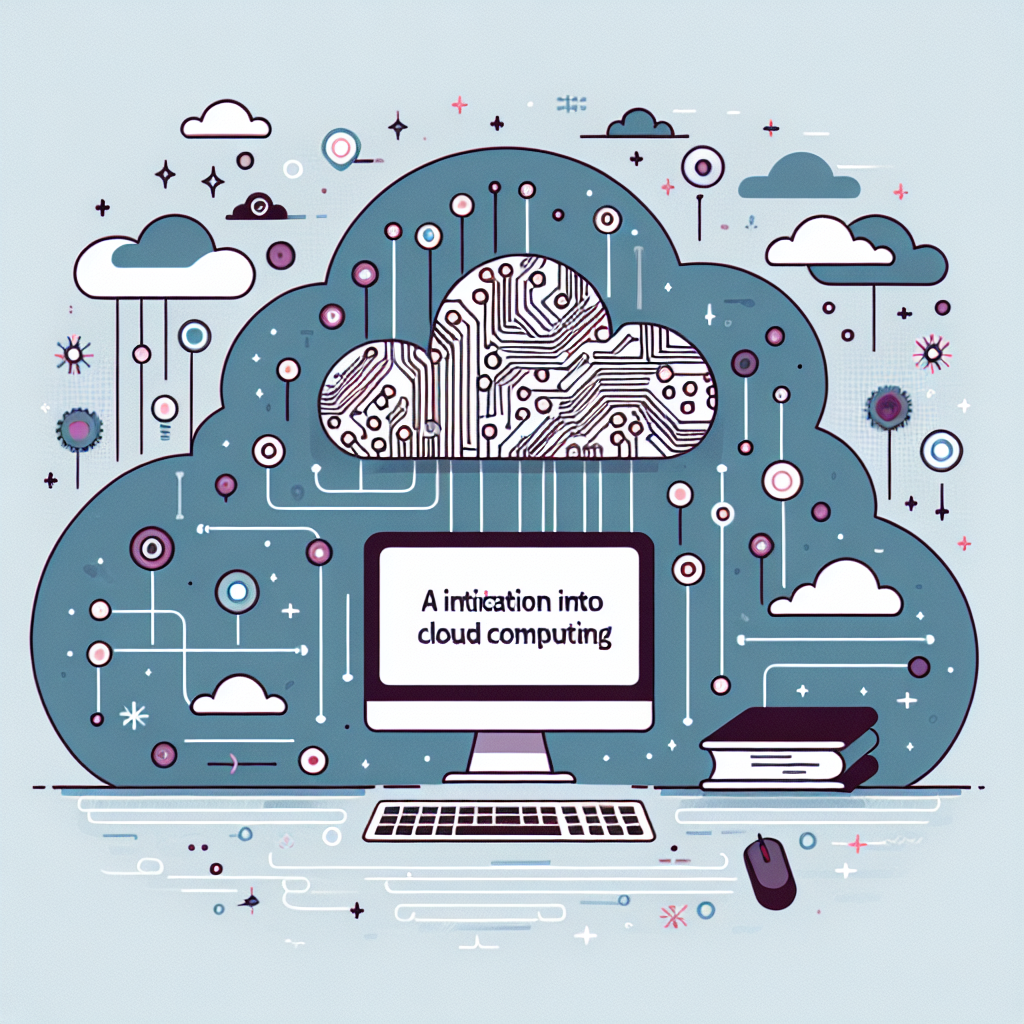Your cart is currently empty!
Tag: cloud computing

The Environmental Benefits of Cloud Computing: Reducing Carbon Footprints
Cloud computing has become increasingly popular in recent years, offering businesses and individuals the ability to store and access data and applications over the internet rather than on physical hardware. While the convenience and cost-effectiveness of cloud computing are widely acknowledged, another significant benefit that often goes overlooked is its positive impact on the environment.One of the main environmental benefits of cloud computing is its ability to reduce carbon footprints. Traditional on-premise data centers require a significant amount of energy to operate, leading to high levels of carbon emissions. In contrast, cloud computing providers can achieve economies of scale by consolidating data storage and processing in large, energy-efficient data centers. These data centers are designed to maximize energy efficiency, using advanced cooling and power management systems to minimize energy consumption.
By using cloud computing services, businesses can reduce their energy consumption and carbon emissions significantly. In fact, a study by the Lawrence Berkeley National Laboratory found that moving business applications to the cloud can reduce energy consumption by up to 87% and carbon emissions by up to 84%. This is because cloud providers can optimize their data centers for energy efficiency, using renewable energy sources and innovative technologies to minimize their environmental impact.
Another environmental benefit of cloud computing is its ability to promote virtualization and resource sharing. Virtualization allows multiple virtual servers to run on a single physical server, maximizing resource utilization and reducing the need for additional hardware. This not only saves energy and reduces carbon emissions but also helps to minimize electronic waste by extending the lifespan of existing hardware.
Furthermore, cloud computing enables businesses to scale their IT infrastructure up or down based on their needs, reducing the amount of unused capacity and associated energy consumption. This flexibility allows businesses to adapt to changing demands without the need for additional hardware, further reducing their environmental impact.
In addition to reducing carbon footprints, cloud computing can also help businesses achieve their sustainability goals by providing tools and resources for monitoring and managing their energy consumption. Cloud-based analytics platforms can help businesses track their energy usage and identify opportunities for improvement, enabling them to make informed decisions that can further reduce their environmental impact.
Overall, the environmental benefits of cloud computing are significant and should not be overlooked. By leveraging the energy efficiency, resource sharing, and scalability of cloud computing services, businesses can reduce their carbon footprints and contribute to a more sustainable future. As the demand for cloud computing continues to grow, it is essential for businesses to consider the environmental implications of their IT infrastructure and take advantage of the opportunities that cloud computing offers to reduce their environmental impact.

Getting Started with Cloud Computing: A Beginner’s Guide
Cloud computing has revolutionized the way businesses and individuals store, access, and manage data. Instead of relying on physical hardware and local servers, cloud computing allows users to access resources and services over the internet from anywhere in the world. If you’re new to cloud computing and unsure of where to start, this beginner’s guide will help you understand the basics and get started on your cloud computing journey.1. Understanding Cloud Computing: Before diving into cloud computing, it’s important to understand what it is and how it works. In simple terms, cloud computing involves the delivery of computing services, such as storage, servers, networking, databases, and software, over the internet. These services are provided by cloud service providers, who manage and maintain the infrastructure needed to run these services.
2. Types of Cloud Computing: There are three main types of cloud computing services: Infrastructure as a Service (IaaS), Platform as a Service (PaaS), and Software as a Service (SaaS). IaaS provides virtualized computing resources, such as servers and storage, over the internet. PaaS offers a platform for developers to build, deploy, and manage applications. SaaS allows users to access software applications over the internet, without the need for installation or maintenance.
3. Benefits of Cloud Computing: Cloud computing offers numerous benefits, including cost savings, scalability, flexibility, and improved collaboration. By moving to the cloud, businesses can reduce their IT costs by eliminating the need for physical hardware and on-premises servers. Cloud computing also allows for easy scalability, as users can quickly add or remove resources as needed. Additionally, cloud-based applications can be accessed from any device with an internet connection, enabling remote work and collaboration.
4. Getting Started with Cloud Computing: To get started with cloud computing, you’ll first need to choose a cloud service provider. Some of the leading providers include Amazon Web Services (AWS), Microsoft Azure, and Google Cloud Platform. Each provider offers a range of services and pricing options, so it’s important to research and compare before making a decision.
Once you’ve selected a provider, you can sign up for an account and start exploring the services they offer. Many providers offer free trials or credits for new users, allowing you to test out their services before committing to a paid plan. You can start by creating virtual servers, setting up storage, or deploying applications on the cloud.
5. Best Practices for Cloud Computing: As you navigate your cloud computing journey, it’s important to follow best practices to ensure the security and efficiency of your cloud environment. This includes implementing strong security measures, such as encryption, access controls, and regular backups. It’s also important to monitor your cloud resources and optimize their usage to minimize costs.
In conclusion, cloud computing offers a wealth of opportunities for businesses and individuals looking to streamline their operations and access resources on-demand. By understanding the basics of cloud computing, choosing the right provider, and following best practices, you can make the most of this powerful technology and take your computing to the next level.

Exploring the Future of Cloud Computing: Trends and Innovations
Cloud computing has revolutionized the way businesses store, manage, and access their data. With the increasing demand for more efficient and flexible IT solutions, the future of cloud computing looks promising with new trends and innovations emerging to meet the evolving needs of businesses.One of the key trends in cloud computing is the move towards hybrid cloud solutions. Hybrid cloud combines the benefits of both public and private cloud environments, allowing businesses to leverage the scalability and cost-effectiveness of public clouds while maintaining the security and control of private clouds. This hybrid approach is becoming increasingly popular as businesses seek to optimize their IT infrastructure and workload management.
Another trend in cloud computing is the rise of edge computing. Edge computing involves processing data closer to where it is generated, rather than relying on centralized data centers. This approach reduces latency and improves performance for applications that require real-time processing, such as IoT devices and autonomous vehicles. By distributing computing resources closer to the edge of the network, businesses can improve efficiency and deliver faster, more responsive services to their customers.
Innovations in cloud computing are also driving the future of the industry. One of the most exciting developments is the adoption of artificial intelligence and machine learning in cloud services. These technologies enable businesses to automate processes, analyze vast amounts of data, and make data-driven decisions in real-time. By integrating AI and machine learning into cloud platforms, businesses can unlock new insights, improve efficiency, and drive innovation.
Another innovation shaping the future of cloud computing is the rise of serverless computing. Serverless computing eliminates the need for businesses to manage servers and infrastructure, allowing them to focus on developing and deploying applications. By abstracting away the underlying infrastructure, serverless computing simplifies development processes, reduces costs, and improves scalability. This approach is particularly beneficial for businesses looking to accelerate their digital transformation and innovate at a faster pace.
As the demand for cloud computing continues to grow, businesses can expect to see further advancements in areas such as cloud security, multi-cloud management, and containerization. These trends and innovations will help businesses stay competitive, improve operational efficiency, and drive growth in the digital economy.
In conclusion, the future of cloud computing is bright, with new trends and innovations shaping the industry and enabling businesses to unlock new opportunities. By embracing hybrid cloud solutions, edge computing, AI and machine learning, serverless computing, and other advancements, businesses can harness the power of cloud computing to drive innovation, improve efficiency, and stay ahead of the competition.

The Benefits of Cloud Computing: How Businesses Can Save Time and Money
Cloud computing has revolutionized the way businesses operate in the modern world. By utilizing remote servers to store, manage, and process data, businesses can save both time and money while also improving their overall efficiency. In this article, we will explore the various benefits of cloud computing and how businesses can leverage this technology to their advantage.One of the biggest advantages of cloud computing is its cost-effectiveness. By moving their data and applications to the cloud, businesses can significantly reduce their IT expenses. Instead of investing in expensive hardware and software, companies can simply pay for the services they need on a subscription basis. This pay-as-you-go model allows businesses to scale their resources up or down as needed, saving them money in the long run.
In addition to cost savings, cloud computing also offers businesses greater flexibility and agility. With cloud-based services, employees can access their data and applications from anywhere in the world, as long as they have an internet connection. This allows for remote work, collaboration, and increased productivity. Moreover, cloud computing enables businesses to quickly deploy new applications and services, making it easier for them to adapt to changing market conditions and stay ahead of the competition.
Another key benefit of cloud computing is its reliability and security. Cloud service providers have robust security measures in place to protect their clients’ data from cyber threats and data breaches. Additionally, cloud servers are backed up regularly, ensuring that data is always safe and accessible. This level of security and reliability is often beyond what most businesses can achieve on their own, making cloud computing an attractive option for companies of all sizes.
Furthermore, cloud computing can also help businesses save time by automating routine tasks and streamlining processes. With cloud-based services, businesses can automate data backups, software updates, and system maintenance, freeing up their IT staff to focus on more strategic initiatives. This increased efficiency can lead to faster decision-making, improved customer service, and ultimately, greater success for the business.
In conclusion, cloud computing offers a multitude of benefits for businesses looking to save time and money. By leveraging the power of the cloud, companies can reduce their IT costs, increase their flexibility and agility, enhance their security and reliability, and streamline their operations. As technology continues to evolve, cloud computing will undoubtedly become an essential tool for businesses looking to stay competitive in the digital age.

Navigating the Cloud: Choosing the Right Cloud Computing Solution for Your Needs
Cloud computing has revolutionized the way businesses operate in today’s digital world. With the ability to access and store data and applications over the internet, cloud computing offers a flexible and cost-effective solution for businesses of all sizes. However, with so many options available, choosing the right cloud computing solution for your needs can be a daunting task. In this article, we will explore how to navigate the cloud and find the best solution for your business.The first step in choosing the right cloud computing solution is to assess your business needs. Consider factors such as the size of your business, the type of data and applications you need to store and access, and your budget. Do you need a public, private, or hybrid cloud solution? Public clouds are hosted by third-party providers and offer a cost-effective and scalable option for businesses with varying needs. Private clouds, on the other hand, are dedicated to a single organization and offer greater control and security. Hybrid clouds combine elements of both public and private clouds, allowing businesses to leverage the benefits of both.
Next, consider the level of security and compliance required for your data and applications. Security is a top priority for businesses when it comes to cloud computing, so be sure to choose a provider that offers robust security measures such as encryption, firewalls, and access controls. Additionally, consider whether your industry has specific compliance requirements that need to be met, such as HIPAA for healthcare organizations or GDPR for businesses operating in the European Union.
Another important factor to consider when choosing a cloud computing solution is scalability. As your business grows, your cloud computing needs may change. Look for a provider that offers flexible and scalable solutions that can easily accommodate your changing business requirements. Consider factors such as storage capacity, processing power, and bandwidth to ensure that your cloud computing solution can grow with your business.
Finally, consider the level of support and service offered by the cloud computing provider. Look for a provider that offers 24/7 technical support, regular updates and maintenance, and a service level agreement (SLA) that guarantees uptime and performance. A reliable and responsive provider can help ensure that your cloud computing solution operates smoothly and efficiently.
In conclusion, navigating the cloud and choosing the right cloud computing solution for your business requires careful consideration of your needs, security requirements, scalability, and support. By taking the time to assess your requirements and research different providers, you can find a cloud computing solution that meets your needs and helps your business succeed in today’s digital landscape.

Common Misconceptions About Cloud Computing Debunked
Cloud computing has become an integral part of modern business operations, but there are still many misconceptions surrounding this technology. In this article, we will debunk some of the most common myths about cloud computing.Myth 1: Cloud computing is not secure
One of the biggest misconceptions about cloud computing is that it is not secure. Many people believe that storing data on the cloud makes it more vulnerable to cyber attacks. However, the reality is that cloud service providers invest heavily in security measures to protect their customers’ data. They use encryption, firewalls, and other security protocols to ensure that data is safe from unauthorized access.
Myth 2: Cloud computing is expensive
Another common misconception is that cloud computing is expensive. While there are costs associated with using cloud services, such as monthly subscription fees, the overall cost of cloud computing is often lower than traditional on-premise solutions. Cloud computing eliminates the need for expensive hardware and software investments, as well as the costs of maintaining and upgrading them. Additionally, cloud services are scalable, so businesses only pay for what they use.
Myth 3: Cloud computing is only for large businesses
Some people believe that cloud computing is only suitable for large enterprises with vast amounts of data and resources. However, cloud computing is equally beneficial for small and medium-sized businesses. Cloud services can help smaller businesses access enterprise-level technology at a fraction of the cost. They can also benefit from the flexibility and scalability of cloud computing, allowing them to grow and adapt to changing business needs.
Myth 4: Cloud computing is complex
Many people think that cloud computing is complicated and difficult to implement. While there may be a learning curve for some businesses, cloud service providers offer user-friendly interfaces and tools to make the transition to the cloud as smooth as possible. Additionally, many cloud services are designed to be plug-and-play, requiring minimal technical expertise to set up and use.
Myth 5: Cloud computing is unreliable
Some people worry that relying on cloud services means putting their business at risk of downtime and service interruptions. While no technology is immune to outages, cloud service providers have high levels of redundancy and disaster recovery measures in place to minimize downtime. Additionally, businesses can choose to spread their data across multiple cloud providers for added resilience.
In conclusion, cloud computing is a powerful technology that can benefit businesses of all sizes. By debunking these common misconceptions, businesses can better understand the benefits of cloud computing and make informed decisions about incorporating it into their operations.

The Environmental Impact of Cloud Computing: Is It Really Green?
Cloud computing has been touted as a green technology solution, with promises of reducing the environmental impact of traditional IT infrastructure. However, the reality of the environmental impact of cloud computing is more complex than it may seem.On the surface, cloud computing appears to be a more sustainable technology option, as it allows for the consolidation of IT resources and the sharing of computing power among multiple users. This leads to increased energy efficiency and reduced carbon emissions compared to on-premise data centers. In fact, a study by the Lawrence Berkeley National Laboratory found that moving to the cloud can reduce energy consumption and carbon emissions by up to 87%.
However, the environmental impact of cloud computing is not solely determined by energy efficiency. The rapid growth of the cloud computing industry has led to an increase in the construction of data centers, which require large amounts of energy to build and operate. These data centers also produce a significant amount of heat, which must be cooled using energy-intensive cooling systems.
Additionally, the disposal of electronic waste generated by cloud computing poses a significant environmental threat. As cloud computing services are constantly updated and replaced, old hardware and equipment must be disposed of properly to prevent toxic substances from entering the environment.
Furthermore, the reliance on cloud computing can lead to an increase in overall energy consumption, as users may be more inclined to store and access large amounts of data in the cloud, leading to higher energy usage and carbon emissions.
Despite these challenges, there are steps that can be taken to mitigate the environmental impact of cloud computing. Some cloud providers are investing in renewable energy sources, such as solar and wind power, to power their data centers. Additionally, efforts can be made to improve the energy efficiency of data centers through the use of energy-efficient hardware and cooling systems.
Ultimately, the environmental impact of cloud computing is a complex issue that requires careful consideration and ongoing efforts to improve sustainability. While cloud computing has the potential to reduce energy consumption and carbon emissions compared to traditional IT infrastructure, it is important to address the challenges and work towards a more sustainable future for cloud computing. By taking proactive steps to reduce energy consumption, improve energy efficiency, and properly manage electronic waste, the environmental impact of cloud computing can be minimized.

The Future of Computing: Exploring the Benefits of Cloud Computing
Cloud computing has revolutionized the way we use and store data, offering numerous benefits and opportunities for businesses and individuals alike. With the increasing popularity and adoption of cloud computing, it’s clear that this technology is the future of computing.One of the main benefits of cloud computing is the flexibility it offers. Instead of storing data on physical hardware, cloud computing allows users to access their data and applications from anywhere with an internet connection. This means that employees can work remotely, increasing productivity and efficiency. Additionally, cloud computing allows for easy scalability, as users can easily increase or decrease their storage capacity as needed.
Another key benefit of cloud computing is cost savings. By utilizing the cloud, businesses can reduce the need for expensive hardware and maintenance costs. Instead, they can pay for the services they use on a pay-as-you-go basis, saving money in the long run. Additionally, cloud computing can help businesses save on energy costs, as they no longer need to power and cool large data centers.
Security is also a major concern for businesses when it comes to storing data. With cloud computing, data is stored in secure data centers with advanced encryption and security measures in place. This provides peace of mind for businesses, knowing that their data is safe and protected from cyber threats.
Collaboration and innovation are also key benefits of cloud computing. With cloud-based applications, teams can easily collaborate on projects in real-time, regardless of their location. This fosters creativity and innovation, as employees can easily share ideas and work together to achieve common goals.
Overall, the future of computing lies in cloud computing. With its numerous benefits, including flexibility, cost savings, security, collaboration, and innovation, it’s clear that cloud computing is here to stay. Businesses and individuals alike can benefit from adopting cloud computing technology, paving the way for a more efficient and connected future.

The Environmental Impact of Cloud Computing: Sustainability and Efficiency
Cloud computing has become an integral part of our daily lives, allowing us to access and store data and applications on remote servers instead of on our personal devices. While the benefits of cloud computing are clear – increased accessibility, cost savings, and scalability – the environmental impact of this technology is often overlooked.The environmental impact of cloud computing stems from the energy consumption of data centers that house servers and store the vast amounts of data that we generate and use every day. Data centers consume a significant amount of electricity to power and cool the servers, leading to a substantial carbon footprint. In fact, data centers are estimated to account for around 1% of global electricity consumption, and this number is expected to grow as the demand for cloud services continues to increase.
However, cloud computing also offers opportunities for sustainability and efficiency. By consolidating data and applications on shared servers, cloud providers can achieve economies of scale and reduce energy consumption compared to traditional on-premises data centers. Additionally, cloud providers are increasingly investing in renewable energy sources such as solar and wind power to power their data centers, further reducing their carbon footprint.
Another way that cloud computing can contribute to sustainability is through virtualization and resource optimization. By dynamically allocating computing resources based on demand, cloud providers can minimize energy consumption and reduce the need for additional hardware. This not only improves efficiency but also extends the lifespan of hardware, ultimately reducing electronic waste.
Furthermore, cloud computing enables remote work and telecommuting, which can help reduce greenhouse gas emissions from commuting and office buildings. By allowing employees to work from anywhere, cloud computing can help organizations reduce their carbon footprint and promote a more sustainable work environment.
In conclusion, while cloud computing does have an environmental impact, it also offers opportunities for sustainability and efficiency. By leveraging renewable energy sources, optimizing resource allocation, and promoting remote work, cloud providers can reduce their carbon footprint and contribute to a more sustainable future. As consumers and businesses increasingly rely on cloud services, it is important for cloud providers to prioritize sustainability and invest in environmentally-friendly practices to minimize their impact on the planet.

